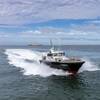Clearly no ordinary passengers, the five people in blue jump suits were met dockside by a pacing ship's officer who whisked them past waiting crew and passengers to the captain's snuggery off the Carnival Imagination bridge.
Imagination's Capt. Angelo Los offered the group a set of plastic binders bulging with maintenance records and safety certificates for the 2,052-passenger cruise ship.
The four men and one woman were inspectors from the U.S. Coast Guard's Miami station and had come aboard the ship to make sure Imagination was fit to carry passengers from U.S. ports.
The inspectors would check equipment, oversee firefighting and evacuation drills, quiz crew on safety procedures, review records and order any repairs that might be needed to ensure the ship could cope with emergencies at sea.
A nightmare for U.S. maritime safety officials is the possibility of a big fire at sea aboard a cruise ship, the largest of which carry more than 5,000 people, equivalent to small cities afloat. Firefighting aid and rescue could be hours away, making onboard equipment and drills crucial.
The inspections also carry financial risks for the cruise lines, including Imagination's owner, Carnival Corp., the world's biggest cruise group with 45 ships at sea. A failed inspection can mean canceled sailings, which translate not only into ruined vacations and news stories about unhappy passengers but losses that can easily add up to millions of dollars.
Less than two weeks before the Imagination's long-scheduled inspection - the most intensive of four that every cruise ship stopping at U.S. ports undergoes each year - the Coast Guard had refused to let the Norway sail with passengers from Miami.
Inspectors required welding repairs on 106 sections of the Norway's sprinkler system. Fearing that temporary fixes could fail and cripple its sprinklers during a fire, they refused to allow the ship to leave Miami with passengers, and the Norway lost a week of sailing the Caribbean.
"With (something) like that you can leave, just not with passengers," said Lt. Richard Pruitt, one of the Imagination's inspectors.
Norwegian Cruise Line, owner of the 40-year-old Norway, declined to detail its costs for refunding ship and air fares for 2,032 passengers, as well as handing out free weeklong cruises as compensation and paying travel agents commissions.
Royal Caribbean, the No. 2 cruise group with $2.8 billion in revenues last year, calculated that cancellations in June of three cruises in Europe and Alaska due to mechanical problems would knock some 20 percent off the firm's quarterly profits.
Led by Lt. Timothy List, the inspectors on the Imagination scanned and reviewed hundreds of documents and logs and questioned the captain, his officers and senior fleet executives from Carnival on procedures.
They also spoke to a visiting inspector from a classification society, private entities hired by cruise operators to audit their vessels for compliance with international sea rules. Critics say the societies are insufficient to oversee the cruise lines and charge that oversight of the $12 billion global business is too lax.
Industry officials say safety is paramount aboard cruise ships and insist their record is very impressive, especially in the world's biggest cruise market, North America, where nearly 6.9 million people took cruises in 2000. Since 1992, 31 fires at sea have been reported in North America, injuring 170 people and leaving six crew members dead.
On the Imagination, after departing passengers had left and the crew had cleaned and loaded supplies feverishly for those due within hours, List ordered the ship's fire alarm rung.
The purpose was to test the responses of the 920 crew, especially those assigned to firefighting and rescue. But List added a challenge, saying the simulated blaze was in the ship's main theater, a key rendezvous in emergencies, requiring hundreds of crew to move to a backup mustering station.
Within five minutes the first firefighters inched into the theater, normally the scene for comedians and musical acts. Dressed in yellow rubber suits and boots, the helmeted trio dragged a hose, wore oxygen tanks and moved in short, rhythmic steps as though the chamber was filled with smoke.
They were looking both for the fire and for anyone in need of help and quickly came upon a man-sized dummy lying flat in the center aisle. The firefighters stopped, radioed for help, then halted until others came to move the dummy laboriously.
They were later mildly criticized for temporarily giving up the search for the fake fire, in this instance an oversized flashlight onstage. "Fire's in here," one of the inspectors finally said, poking his head through the stage curtains hiding the flashlight from the firefighters.
The inspectors then roamed the Imagination, a $300 million ship at sea since 1996, questioned croupiers, housekeepers, bartenders, laundry staff and engineers on where extra life preservers were located, how to handle passengers in wheelchairs and what items were in the lifeboats, as well as overseeing evacuations on a half dozen lifeboats.
"The drills were satisfactory," List told the captain. "They were on scene, dressed out pretty quickly."
For other checks during the six hours they were aboard, the Coast Guard inspectors broke into teams and visited the massive, hot engine room, kitchens, ship's laundry, backup generators, incinerator chamber and wastewater tanks.
They ordered tests, took samples and tried countless doors that isolate fires during emergencies.
At a third and final meeting with the captain, List told him a Coast Guard Certificate of Inspection, good for one year, would be issued. "We have no deficiencies to report," he said. -- (Reuters)
Featured videos

Unlock Onboard Data Efficiencies

Tracking Foreign Vessels Working in the U.S. Jones Act Market

Inmarsat Enhances Service to Drive Digitalization
Subscribe for
Maritime Reporter E-News
Maritime Reporter E-News is the maritime industry's largest circulation and most authoritative ENews Service, delivered to your Email five times per week








